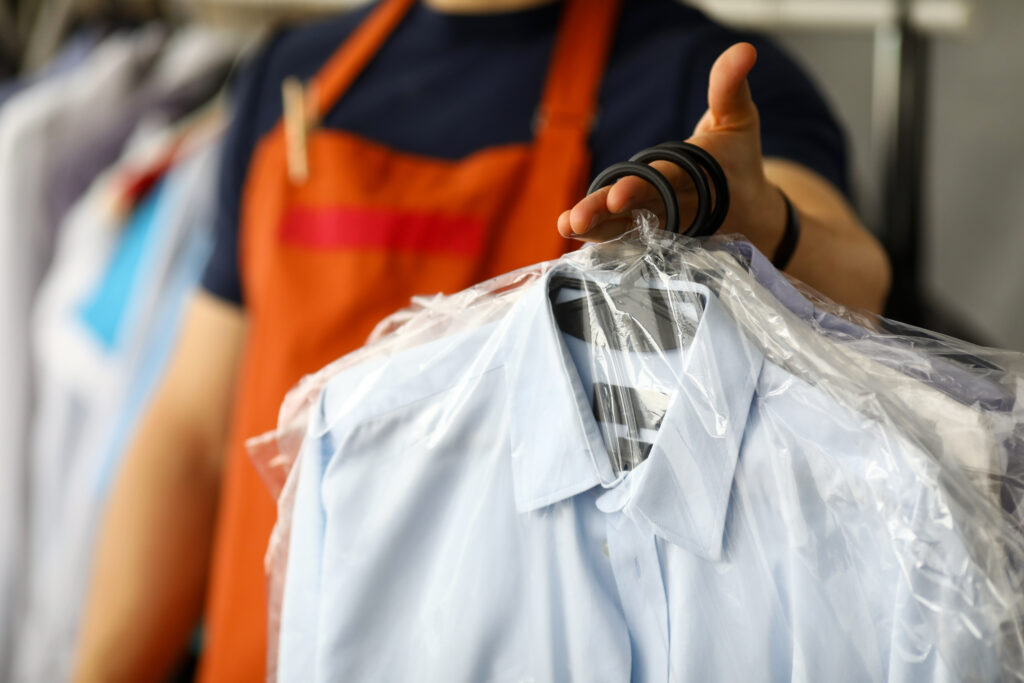Laundry is part of our day-to-day lives. A recent study involving 2,000 American parents revealed that 50% of them do seven loads of laundry (or more) every single week. Now, that’s a lot of laundry. Thankfully, the invention of washing machines, detergents, fabric softeners, stain removers, and other laundry tools has made it much easier for people to do their laundry regularly. (1)
However, not all garments are designed to withstand the rough and tumble of a regular washing machine. In that case, dry cleaning may be an option. This alternative is a specialized cleaning method designed to clean fabrics that would otherwise get damaged by water and regular washing.
Even though it’s called dry cleaning, it’s not actually “dry.” This method has been perfected over the years to effectively remove stains while keeping the quality, color, and texture of delicate fabrics that can’t handle traditional washing. If you’re curious about how dry cleaning works and why it’s so effective for your delicate items, keep reading!
What Makes Dry Cleaning Different From Regular Laundry
Regular laundry primarily uses water, along with detergents, to break down dirt and stains. While effective for many fabrics, water can cause certain materials to shrink, warp, or lose their shape. Colors might also bleed, and delicate fibers can break down under the mechanical stress of a washing machine.
Dry cleaning, on the other hand, takes a whole different approach. Instead of water, it uses specialized chemical solvents that can dissolve oils and greases without damaging sensitive fabrics. The main difference comes down to chemistry: water is polar, which means it’s great for water-soluble stains but not so much for oily ones. Dry cleaning solvents are non-polar, making them perfect for removing grease, oil, and many stains that water-based cleaning can’t touch.
So, if you have clothes made from sensitive fabrics like leather, cashmere, wool, or silk, it’s best to take them to the nearest dry cleaners in your local area. They have the complete tools for dry cleaning your garments and assure you that your delicate clothes are cleaned well while preserving their quality.
How the Dry Cleaning Process Actually Works
Here’s what happens after you drop off your clothes at the dry cleaners:
Inspection and Tagging
First, your clothes are examined for stains, damage, or forgotten items in pockets. Even small details like a missing button, broken zippers, or a weak seam are noted to avoid further damage during cleaning. Each piece of clothing receives a unique identification tag during garment inspection to track it through the cleaning process.
Pre-Treatment
Stains aren’t created equal. Oil-based stains (grease, makeup) require different treatment than water-based ones (coffee, wine). The dry cleaning expert will apply specialized solutions to break down different types of stains before the main cleaning cycle.
The Cleaning Cycle
After the pre-treatment, your clothes are loaded into a specialized machine that looks similar to a commercial washing machine. But instead of water, the drum is filled with a chemical solvent (traditionally perchloroethylene or “perc,” though more environmentally friendly alternatives are increasingly common). The machine gently agitates the garments, allowing the liquid solvent to dissolve dirt, stains, and oils.

Solvent Filtration
Throughout the cleaning cycle, the solvent continually filters through the machine, removing dissolved dirt particles while the clean solvent continues to circulate through the clothes.
Extraction and Recovery
After cleaning, the machine spins to extract the solvent from the garments. Modern dry cleaning machines recover and distill this solvent for reuse, making the process more economical and environmentally responsible.
Drying and Post-Spotting
The clothes undergo a carefully controlled drying process (that doesn’t involve exposure to direct sunlight) to remove remaining traces of solvent. If any stubborn stains don’t budge during the main cleaning cycle, they get a little extra attention in the post-spotting phase.
Finishing Touches
Finally, you have the finishing touches. This important step involves pressing, steaming, and ironing to bring back the garment’s original shape and appearance. Professional pressers use specialized tools to achieve results that are tough to replicate at home.
The next time you drop off your favorite jacket or that “dry clean only” dress, you’ll have a better idea of the processes it needs to go through just to become clean and stain-free again.
The Benefits of Professional Dry Cleaning
Dry cleaning can be anywhere from USD$3 to USD$9 per item, with a minimum order usually between USD$25 and USD$30. But when you think about the benefits, it’s a smart investment for your special garments. (2)
Here are some key advantages that make dry cleaning services a preferred choice for maintaining high-quality apparel:
- Superior stain removal: The solvents used in the dry cleaning cycle can dissolve oil-based stains that water-based cleaning struggles with. Makeup, cooking oils, grease, and many other stubborn stains respond better to dry cleaning.
- Preservation of fabric integrity: By avoiding water, dry cleaning prevents shrinkage, fabric distortion, and color bleeding that can occur with the traditional washing process.
- Extended garment life: Professional dry cleaning is gentler on clothes than machine washing. Regular dry cleaning can extend the lifespan of investment pieces like suits, formal dresses, and high-quality outerwear.
- Maintains structure and fit: Tailored clothes retain their precise fit and structure much longer when dry-cleaned. The entire process preserves internal components like interfacing, shoulder pads, and linings that give garments their shape.
- Professional Finishing: The pressing and finishing techniques that professional dry cleaners use are hard to replicate at home. The end result? Crisp, wrinkle-free clothing that looks brand new.
- Time-Saving: On average, most people spend 30 to 40 minutes doing laundry. But for those with busy schedules, those minutes can feel like an eternity! The convenience of dropping off your laundry at the dry cleaners and picking it up clean, pressed, and ready to wear can be a huge advantage. (3)
When you really think about it, professional dry cleaning is more than just getting your clothes clean; but about taking care of your wardrobe investments. Those special items deserve a little extra attention, and sometimes, trying to do it yourself just doesn’t cut it.
While it might cost a bit more at first, it pays off when your favorite blazer or dress lasts for years longer than it would otherwise.
Key Takeaway
Dry cleaning is a practical way to care for your clothes that need special attention. With a mix of unique and effective solvents, precise technology, and skilled techniques, it keeps delicate fabrics safe from the harm that water can do. So, next time you’re unsure about tossing a delicate item in the wash, remember that sometimes, the best care means keeping it dry.
References:
1. “Whirlpool Brand Study Reveals American Families Claim To Wash More Than 2,000 Pounds Of Laundry Per Year”, Source: https://www.prnewswire.com/news-releases/whirlpool-brand-study-reveals-american-families-claim-to-wash-more-than-2-000-pounds-of-laundry-per-year-301320187.html
2. “How much does laundry service cost?”, Source: https://homeguide.com/costs/laundry-service-cost
3. “How long should it take to wash and dry clothes? Plus, how to speed it up”, Source: https://www.homesandgardens.com/solved/how-long-should-it-take-to-wash-and-dry-clothes












